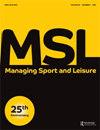身体距离对团队凝聚力的重要性——以美国7人橄榄球赛为例
IF 1.8
Q3 MANAGEMENT
引用次数: 0
摘要
研究问题:本文试图对体育运动中团队凝聚力的理论理解做出贡献。虽然对体育运动中团队凝聚力的研究有着坚实的基础,但对身体接近的作用的研究却很少。由于新冠肺炎,团体体育锻炼暂时暂停,这是一个在保持身体距离的不同阶段检查团队凝聚力的机会。研究方法:采用单例混合方法研究,包括在三个不同时间点(2019年9月;2020年3月;2020月)进行的半结构化访谈(共19次)和GEQ调查的基线/后管理(2019年九月(N=26);2020年8月(N=27))。定性数据在NVivo 12中进行分析,调查数据通过配对t检验进行分析。结果和发现:在整个赛季和保持身体距离期间,在所有三个凝聚力子量表(即ATG-T、GI-S、GI-T)上,团队凝聚力水平保持稳定。出现了三个定性主题:任务和集体忠诚度、通过社会凝聚力实现的韧性以及数字参与。含义:数字交流可以暂时填补面对面交流的空白,但不能长期取代它来建立团队凝聚力。在团队凝聚力的理论概念化中增加身体距离,使该模型更具现代性,尤其是在身体距离较远的时候(例如,疫情、休赛期、远程团队)。©2023作者。由Informa UK Limited出版,交易名称为Taylor&Francis Group。本文章由计算机程序翻译,如有差异,请以英文原文为准。
The importance of physical proximity for team cohesion – a case study of USA Rugby 7s
Research Question: This paper seeks to contribute to the theoretical understanding of team cohesion in sport. While a robust foundation of research on team cohesion in sport exists, there is a dearth of research examining the role of physical proximity. With physical group exercise temporarily suspended due to COVID-19, herein lies an opportunity to examine team cohesion throughout different stages of physical distancing. Research Methods: A single case mixed method study was employed comprised of semi-structured interviews (19 total) conducted at three different time points (September 2019;March 2020;June 2020) and a baseline/post administration of the GEQ Survey (September 2019 (N = 26);August 2020 (N = 27)). Qualitative data were analysed in NVivo 12, and survey data were analysed via paired t-tests. Results and Findings: Levels of team cohesion remained stable throughout the season and during physical distancing on all three cohesion sub-scales (i.e. ATG-T, GI-S, GI-T). Three qualitative themes emerged: task and collective loyalty, resilience through social cohesion, and digital engagement. Implications: Digital communication can temporarily fill the void of face-to-face interaction but cannot replace it long-term to build team cohesion. Adding physical proximity to the theoretical conceptualization of team cohesion makes the model more contemporary and especially relevant during times of physical distancing (e.g. pandemic, off-season, remote teams). © 2023 The Author(s). Published by Informa UK Limited, trading as Taylor & Francis Group.
求助全文
通过发布文献求助,成功后即可免费获取论文全文。
去求助
来源期刊

Managing Sport and Leisure
MANAGEMENT-
CiteScore
6.80
自引率
11.10%
发文量
62
期刊介绍:
Managing Sport and Leisure is a refereed journal that publishes high quality research articles to inform and stimulate discussions relevant to sport and leisure management globally. The journal is committed to publishing research that advances understanding of the practice of sport and leisure management in the public, voluntary and commercial sectors, internationally. It will appeal to anyone with a serious interest in contemporary sport and leisure management issues, including academics, managers, consultants, politicians and students. One of the key objectives of the journal is to provide a high level forum for communication between academics and practitioners of sport and leisure. Therefore Managing Sport and Leisure aims to be contemporary, integrated and, most importantly, relevant to practitioner training. Contributions are welcome and expected from both academics and practitioners throughout the international sport and leisure management community. In addition, the journal welcomes submissions from those investigating new and innovative areas of research and practice in sport and leisure management.
 求助内容:
求助内容: 应助结果提醒方式:
应助结果提醒方式:


